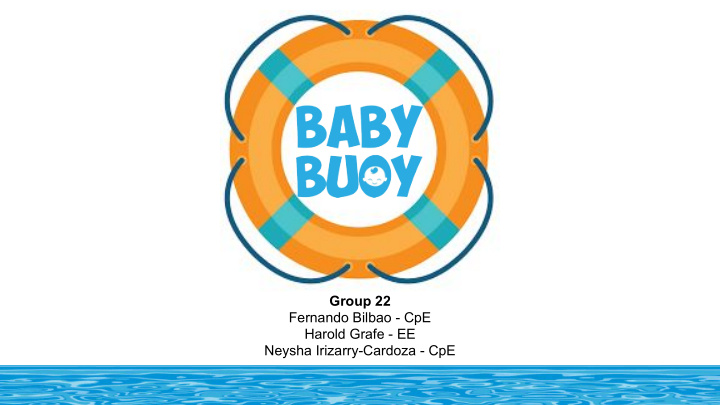



Group 22 Fernando Bilbao - CpE Harold Grafe - EE Neysha Irizarry-Cardoza - CpE
Motivation Florida takes lead in the nation for the number of child fatalities due to drowning. In 2017 there was a total of 51 that passed away from drowning. A 20% increase from 2016. 80% of fatalities reported, are from children of the ages 1-4 and 20% from children of the 15 and younger. *Statistic are taken from the USA Swimming Foundation published by the Miami Herald.
Requirements Specifications ● System shall be portable, durable and have a waterproof housing ○ Up to 10 lbs ● System shall have solar power capabilities to sustain battery life ○ 16 hours between charges ● System shall have wireless communication capabilities ○ Communicate with mobile application ● System shall be triggered when PIR sensor and/or accelerometer are tripped ○ Audible alarm when triggered ○ Visual verification through a camera when triggered
Work Distribution MECHANICAL MOBILE NAME POWER CONTROLLER DESIGN APPLICATION Fernando Secondary Secondary Primary Harold Primary Primary Neysha Primary Secondary
Overall Block Diagram
Microcontroller Comparison Why did we choose the ATmega644PA? ○ Low power consumption ○ Price ○ Memory & RAM ○ Based on Arduino platform
Wireless Communication Comparison ● Why did we choose the ESP8266? ○ Maximum power consumption is the lowest compared to the others ○ Operates with 2.4 GHz wireless frequency ○ Price
Wireless Board and Microcontroller Size
PIR Sensor ● Passive sensor that catches energy (IR) emitted from bodies ● P/N: HC-SR501 ● 3 pins ○ VCC ○ OUTPUT ○ GND ● Operating power consumption @ 5V ○ 325 mW | 65 mA ●
Accelerometer ● Smart 3-axis accelerometer to detect motion, tilt and orientation ● P/N: MMA8451 ● 8 pins ● Communicates via I2C ● Operating power consumption @ 5V ○ 425 µW | 85 µA
Mini Spy Camera ● Takes pictures or videos and stores them to integrated microSD card ● P/N: Adafruit 3202 ● 3 pins ○ VCC ○ OUTPUT ○ GND ● Camera resolution ○ 1280 x 720 for pictures (JPEG) ○ 640 x 480 for videos (AVI) ● 32 GB maximum microSD card support ● Operating power consumption @ 5V ○ 550 mW | 110 mA
Physical Design/Prototyping ● Waterproof solar cell and electronics housings ● Clear acrylic for solar cell housing to allow sunlight through ● Anodized aluminum electronics housing to prevent oxidation ● Two windows for the PIR sensor and camera ● Articulated arm to adjust electronics housing in the water ● Accelerometer buoy attached to the side via wire ● Aluminum rod suspends electronics housing over the edge of the pool
Electronics Housing ● Sturdy aluminum construction ● Waterproofed by 0.1mm tolerance between caps and body plus neoprene gasket ● Caps are fastened with screws ● Acrylic window at the bottom for camera ● Top window is PIR lense included with the sensor ● Cable glands to pass wires from solar cell housing
Accelerometer & Solar Cell Housing ● Solar cell housing made to fit panels, buzzer, and WiFi antenna ● Rubber legs to prevent slipping ● Buzzer is included here to expand the range of the alarm ● WiFi antenna need to be outside electronics housing ● Accelerometer buoy is waterproofed with gasket
Power Management Max Current Component Draw (mA) ● MCU and other components run on 5V PIR Sensor 65 ● LiPo battery was used due to space constraints Camera 110 ● Camera, WiFi, and buzzer only turn on when both the PIR and accelerometer give signal MCU 0.4 ● 235 mA/hr is needed under normal operation, assuming system runs on battery for 16 hrs a WiFi Module 170 day, capacity of 3760 mAh is needed, 5000 Temp. Sensor 0.05 mAh was chosen ● Two solar cells with 600mA output in parallel Buzzer 30 were chosen to charge battery ● 5V switching boost converter was used to Accelerometer 0.165 power system from 3.7V battery Total 375.46
Power System Design
PCB Schematic
PCB Layout
Mobile Application The mobile application will serve as an extra beacon. Sending notification alerts, based on the activities being reported from the pool alarm.
Mobile Operating System iOS apps: Developed on Xcode and written using Swift language. Developer would need a Mac product (Desktop or Laptop). Development on Windows is possible but strenuous. Android apps: Constructed on Android Studios. Written in Java. Developer would need just a basic computer or laptop. Android development is known to be more straightforward. Fantasy: If time permits; development of mobile application in both platforms. Although Android is simpler, we would not want to limit our users to one possible operating system.
Mobile Application Features Monitoring ● Output logs of when sensors are activated do to motion detection. ● Gallery of images captured from underwater camera. ● Water temperature ● Emergency push notification
Use Case Diagram
Class Diagram
Mobile Application UI
Constraints & Standards Economic Constraint: Self funded project. Keeping it cost friendly and competitive with other similar products out in the market. Health and Safety Constraint: Child safety is our #1 concern. Keeping any dangerous and hazardous material sealed, covered and away from small rugrats. IEC 60529 standard: Goes over what would classify an object to be protected from environmental elements. Based on their rating scale our project is scaled as a IP68. Meaning, dust tight and protected against immersion in water for long periods of time.
Budget ● Self-sponsored project ○ Overall budget of $500 for research & development purposes ● Retail price of $300 ○ Similar devices are retailed at $300 to $420
Progress
Issues ● PIR sensor incapable of accurately detecting motion underwater. ● Calibrating sensitivity of accelerometer. ● Housing creates a Faraday cage for WiFi signal.
Questions?
Recommend
More recommend